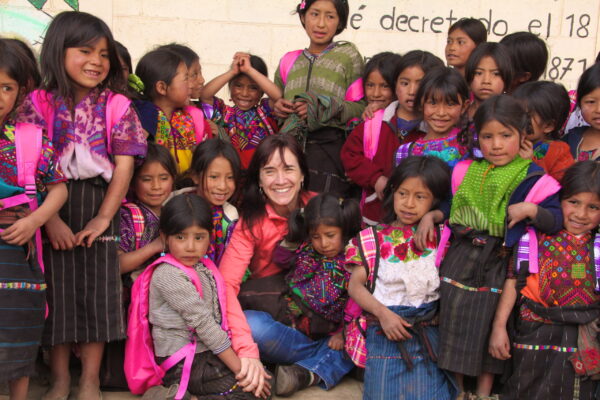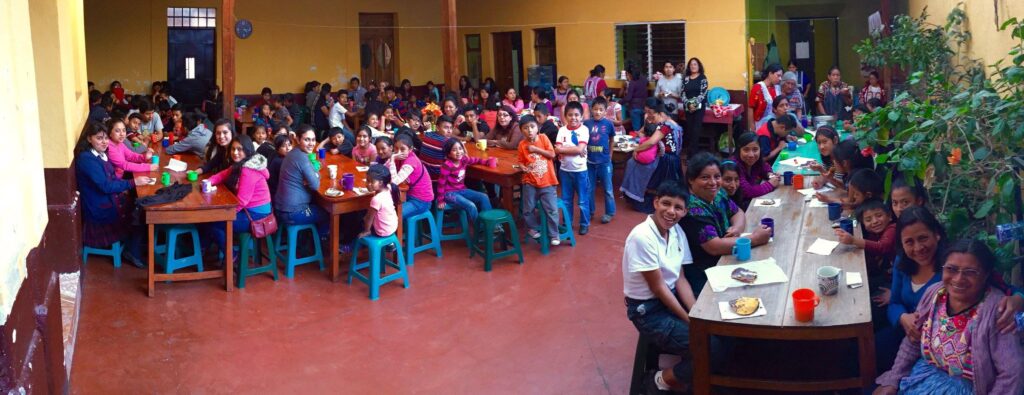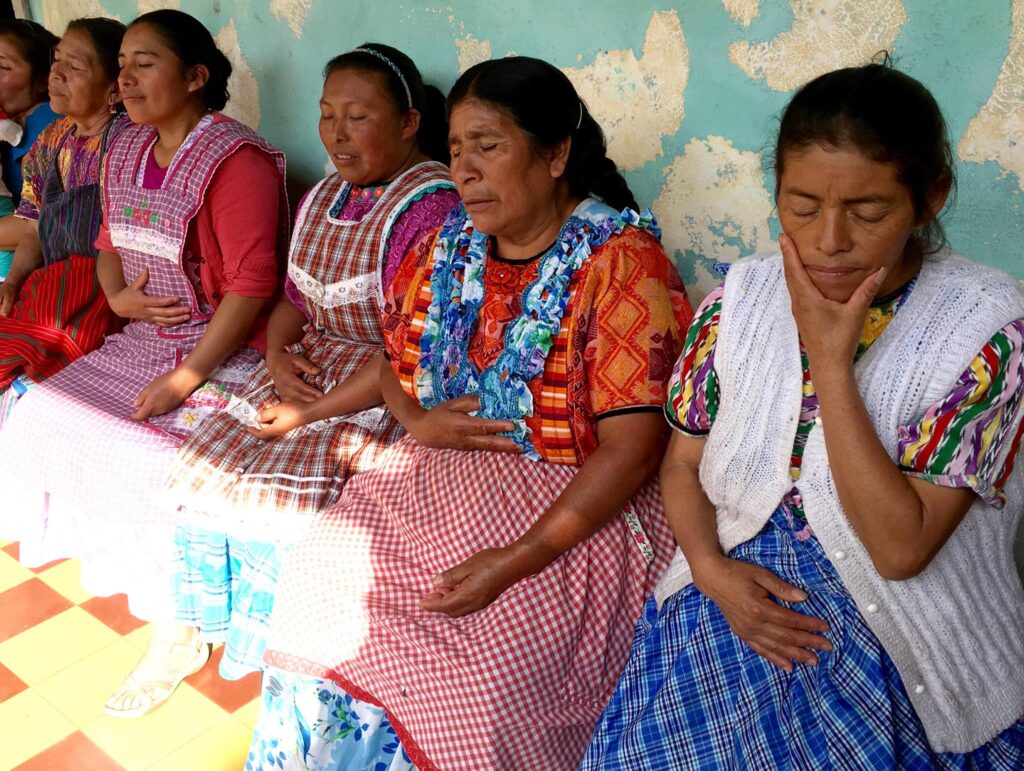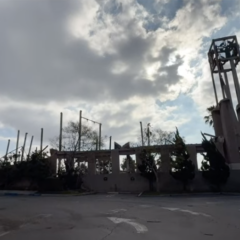On any given afternoon, for the last 22 years, Julie Coyne has waited eagerly at the doorway to Education and Hope, green eyes twinkling. Children emerge from the surrounding streets dressed in school uniforms. They line up and are greeted one at a time with a big hug and Julie’s signature full-face smile. “This part never gets old,” she explains, a look of sheer delight on her face.
Julie never planned to leave her native Connecticut and move to Guatemala permanently. Yet, her life has become interwoven with the community there, just as her two countries are entangled.
A steady stream of migrants, asylum seekers and unaccompanied minors from Guatemala have made their way, at great peril and expense, to the US-Mexico border in recent years. Under the Trump administration’s most recent policies, migrants have been summarily expelled at the border and deported to their country of origin, many carrying coronavirus with them, or they remain stranded in Mexico with court hearings on pause.
Guatemalans are escaping poverty and violence, searching for survival and new life in a country deeply implicated in both their homeland’s instability and the criminal treatment of those who flee it.
But long before the current “border crisis”—before children like Jakelin Caal Maquin and Carlos Hernandez Vásquez died in U.S. Border Patrol custody, and asylum seeking families were told to “remain in Mexico” in dire conditions—locally run Guatemalan projects like Education and Hope have worked to create a microcosm of hope in which families can imagine a future that does not involve migration to the United States.
“What we are doing is not flashy,” explains Julie, the perpetually jean-clad, vivacious 53-year old founder of Education and Hope. “We were here before this latest news cycle, and we will be here long after.”
Julie’s commitment to the unique community she has helped create there is rooted in a spirituality of love—one that is nurtured by the lessons and teachings of a variety of faith traditions, spiritual mentors, and the families she serves.
A Place for Those Living Invisible Lives
Each day, after being greeted by Julie, students of all ages are welcomed into the building by young Guatemalan staff—almost all former graduates of the program. There are high-fives and hugs, personal check-ins, eye contact and a moment of being seen.
Before tutoring begins, students find a seat in the comedor, a light-infused atrium, surrounded by murals from young artists. A team of mothers and grandmothers, dressed in traditional huipiles and traje, bustle around putting the final touches on a nutritious lunch.
Once everyone has gathered and filled their bellies, one can hear Julie’s trademark bellow, “Buenas tardes niiiiños,” followed by a joyous response from the children: “Buenas tardes Juu-li-uh!”
Education and Hope is housed in Quetzaltenango, the second largest city in Guatemala, which is affectionately known by its Maya name, Xela. The city is nestled in a graceful valley in the western highlands, a four-and-a-half-hour bus ride and a world away from Guatemala City, the frenetic capital.
Guatemala is a land of spectacular beauty and deep layers of culture. It boasts some of the most impressive volcanoes and fertile valleys in Latin America. It is the bosom of the Maya Cosmovision, a philosophy that articulates the interrelatedness of all life. And it is home to 24 distinct languages and sophisticated, historic advances in astronomy, engineering and agriculture.
Guatemala is also a land of stunning violence and despair. Eighty percent of the indigenous Maya population live in poverty, with 40 percent subsisting on less than two dollars a day. In indigenous communities, four out of five children struggle with chronic malnutrition, and illiteracy for women hovers around 50 percent. Political corruption, targeted assassinations, criminal extortion and femicide are widespread.
Education and Hope works to buck those trends. The program currently provides 175 comprehensive scholarships, after-school tutoring and hot meals, as well as sustainable wages for 48 employees, almost half of whom are former graduates or the single mothers and grandmothers of enrolled children.
Over the years, the program has provided a million hot meals and graduated nearly 200 children from high school, following each child from early primary school to their logical end—sometimes college, sometimes a job in the project and beyond. In addition to tuition, uniforms, hot meals and tutoring, the program provides showers, medical attention and mental health support, classes in art, computers and physical education, and small loans to families.
The scope may sound small, but in an area where many children will attend school for only a handful of years, if they are lucky, and where malnutrition is the norm, it is anything but.
Yet the real goal of the program goes beyond body and mind.
“Technically we are an education program,” Julie explains, “but that doesn’t quite capture it. We provide a safe space for children who have lived their lives invisibly, and often lived them invisibly with great pain.”
The project has created an environment where people can “lay it all out on the table, let everything air out,” Julie says. “And even if they have to pack it up and carry it back home again, the burden changes and transforms in the sharing. It’s never quite as heavy as it was before you unpacked it.”
José was an early project participant. The year his mother’s health was failing, Julie gave her a bed in the building of Education and Hope, where the señoras who make meals could nurse her daily as she died. Despite the nurture, José lost himself in despair and delinquency for many years following his mother’s death.
There is not a quick fix in this context. You have to follow people all the way, explains Julie. After basic needs are met, trauma can surface, and sometimes kids will begin to act out and do really heartbreaking, self- destructive things. Julie is patient. She has faith that many students have been filled with enough love to eventually cycle back.
Such was the case with José. After years on the street, even stealing from the project, he is now regularly found cutting vegetables before mealtimes with the señoras who saw him through his despair. He graduated high school, has taken a position in the after-school program, and is raising a family of his own.
“Education is good,” José explains shrugging, “but love is much stronger than education.”
Julie is not dogmatically religious, and Education and Hope is not a religious organization, but everything she does comes back to her perception of God’s love. God made us perfectly and we are all worthy of love, she says. This is a theology Julie brought with her to Guatemala many years ago, but one that is now embodied in the families of the project.
“We are all expressions of the divine,” she says.
The Birth of a Project… And a Permanent Stay
Julie grew up in a Catholic family in Connecticut and felt drawn to the cause of social justice. But she never experienced a clear vision that called her unequivocally to leave her middle-class life behind and live in Central America. Instead, she fell into her work in Quetzaltenango.
After college, she traveled to Guatemala to study Spanish before attending graduate school. As a way to engage with the community where she lived, she volunteered in a soup kitchen for children and at a women’s shelter. By her third year in Guatemala, her career path back home seemed even less clear. She had a sense she wanted to help people, but was there a degree for that? Her professors suggested divinity school, but it didn’t feel quite right.
“From where I was sitting on a dirt floor hut in Guatemala with chickens running around and barefoot kids, illiteracy, starvation and extreme poverty, it just didn’t fit. I couldn’t see myself in an ivory tower.” For her, a degree would have to be earned at the divinity school of the streets.
In retrospect, Julie believes a clear “call” to a life of religious service would have sent her running. Instead, the reality of living in Guatemala permanently was hidden from her until she was so far along the path that there was no turning back. She needed a slow transformation to understand and accept this way of life, so far removed from where she began. She sees God at work in her transformation.
Early on, after giving a talk in her Connecticut church community, a contact offered her start-up funds to support her dream of providing access to education to children in need. With that funding, the seeds of what would become Education and Hope were planted. Julie offered scholarships to a handful of children she knew from the soup kitchen and the shelter. Mission accomplished; she had created an education program.
[RoyalSlider Error] Incorrect RoyalSlider ID or problem with query.
The first semester, everyone bombed their classes.
Kids from impoverished families had no one to help with their homework. They had no food to eat. Julie regrouped and invited the kids back to her tiny Guatemala home, a rented, aquamarine block house with a central patio. There she made a big pan of scrambled eggs, the only meal she knew how to prepare for a dozen children. She offered them showers, since they had no running water at home, and they did homework together. Without realizing it, Education and Hope was born.
Even as the young organization began to experience some successes in education, these are not what grounded her in the work, Julie says.
Rather, it was sorrowful experiences that bound her heart with this community: a teenager who died from a brain parasite, a mother who died of AIDS contracted from an abusive husband, leaving five children in Julie’s care. Then a young man committed suicide, and yet another mother died, this time from cirrhosis.
“There was this moment when I was walking in a funeral procession, holding the hand of a young orphan just seven years old, and I had this vision that pieces of my heart, along with everyone around me, were falling into the earth, just falling and absorbing into the soil, binding me to these people, to this place.”
“The universe said, ‘Oh my God, she thinks she can fix everything. Let’s put her in a situation where it is so far beyond her ability to fix it that she’ll have to come to the realization that the goal is not to fix,’” she says. “The goal is companionship, community and connection—and healing through those things. Not healing through fixing; healing through this very experience of love and community.”
It took ten years for Julie to realize she was staying forever.
What Can’t Be Counted
By mid-afternoon, kids in the project have moved to their classrooms. Out in the courtyard, the señoras are taking a break, being led in a Zumba class. “Isn’t this Zumba class just the greatest thing you have ever seen?” Julie says through a gurgling laugh, joining in.
 Funders want to know what Zumba has to do with the organization’s mission. The expectation of funders, who want to see numbers and success stories, often conflict with Julie’s approach. Joyful release is a prerequisite for hope, Julie says about the Zumba class. And where there is hope, there is a path forward.
Funders want to know what Zumba has to do with the organization’s mission. The expectation of funders, who want to see numbers and success stories, often conflict with Julie’s approach. Joyful release is a prerequisite for hope, Julie says about the Zumba class. And where there is hope, there is a path forward.
Kids become a part of Education and Hope as young as toddlers tagging behind parents, and preschoolers in the Montessori-style early childhood program. But the program also supports fifteen-year-old mothers in their desire to start first grade or even kindergarten for the first time. And the señoras who have never been given a chance to study are learning to read, beginning with the alphabet.
Education nonprofits are often wary to accept “high-risk cases.” As Julie describes, someone will say, “You know what, she’s 13 or 14, she’s never been to school. Is this really going to make a difference? Culturally she is more likely to get pregnant in the next couple years than anything else.”
But the transformations that occur in the project are often not quantifiable in a way that “counts” for an annual report.
“Isn’t this young woman the most important one to give a scholarship to?” Julie asks. “Because one year or two years of reading and writing and that love will go so far in her own development, and then her baby is so much more likely to be nourished, and the focus will be on education.” Plus, she will have the extended family of the project forever.
Even as she experiences outward pressures for “success,” Julie’s love-first approach also can put herself at odds with the cultural norms of the area.
A youth explained the Guatemalan expression, “Hay que sacarle la verguenza,” meaning “you have to beat the shame out” of a misbehaving child. Sometimes even her own team feels like Julie offers one too many extra chances.
“Many of us have never experienced one simple ‘I love you’ in our homes,” explained Jenny, a young woman who began at the after-school program following a childhood of abuse and neglect. “But through Education and Hope,” she continued, “we know we have value.” Jenny is a definitive success story. This fall, thirteen years after entering the program, Jenny started her first year of study at Berea College in the US.
To bridge the disconnect between the message children hear at Education and Hope and at home, Julie has introduced tools that travel beyond the organization’s walls, like meditation.
At late afternoon snack-time, which serves as dinner for most, Julie stands in front of a 150 women and youth in the atrium. She asks them to put their feet on the ground and feel themselves rooting down. After long breaths, she asks them to close their eyes and visualize a source of deep love. They extend this love to friends, to somebody difficult, then to the whole program.
She recalls watching an orphan meditate: “I knew he was imagining his mom, with his eyes closed so tightly, he was just working so hard at it. I was filled with that visual of him connecting to this love source that has sustained him and remembering that he could bring it back to himself, even when it’s not physically there.”
“I believe the children and their mothers can witness that they are part of this ability to create change just through summoning love,” Julie says.
The Sustenance to Lead
At the end of the day, Julie returns to her own personal retreat.
In contrast to the joyful noise of the project and being physically and emotionally touched all day, her small home is solitary and quiet. It is set on a green hillside in a small community of cabins outside of town. It is an open, mixed-use space with a sleeping loft upstairs. The walls are lined with hundreds of books, both fiction and nonfiction. String lights, candles and soothing music create a soft ambience. A gaggle of street puppies lives outside the door.
Few people fully grasp the life Julie leads and the all-encompassing nature of the work she does. People who do community work often live in a liminal world—between being present and thinking big picture; being on the ground in the project and fundraising outside of it. They are with the people but not fully of the people. For Julie, it can be taxing and lonely.
Through years of illness and an almost purposeful self-denial, Julie has learned the importance of self-care. She does not have the time or money to take long spiritual retreats. Instead she builds spiritual practices into her day.
She often wakes to a long series of chimes that center her before she begins her workday. And at the end of the day, Julie communes regularly with a host of “saints.” Among her saints are Thomas Merton, Dorothy Day, Archbishop Romero and Mother Teresa. “All those were people who put everything on the table,” she points out, “and, that, at the end of the day, might not be sustainable.”
But there also are contemporary figures, Christian or not, whom she admires: Father Greg Boyle, Ram Dass, Richard Rohr, Pema Chödrön, Nadia Bolz-Weber and Anne Lamott.
“The first time I read Tattoos on the Heart, by Father Greg Boyle, it blew off the top of my head, because I saw myself and my Education and Hope family, my people, in every single page,” she says. Boyle runs Homeboy Industries in Los Angeles, where he mentors gang members as they find a new way of life. His book gave Julie a language—of connection, community and radical kinship—to articulate what she does, and this combats isolation.
He also has become a mentor in real life, she says. “He calls me ‘kiddo.’”
All these voices—activists, saints and writers—“have been my salvation,” Julie says. She still leans on her Catholic roots, but has arrived closer to a Buddhist state of mindfulness.
“What I take from so many of these writings is a sense of being present, a sense of humility and grace in brokenness, in the latest calamity, whether it is something going on in the program or with my own health,” she says. “This is just how it is right now. Learning how to trust that there will be a shift, even if I’m not sure what it will be, but knowing it will never stay this bad or stay this good in the next moment. It will all change. Those ideas about transformation give me hope and fuel my thinking. That helps me be self-sustaining.”
Julie does not keep her spiritual insights to herself. She recharges, and then shares these insights with the kids and the señoras.
While policy-makers fixate on the borderlands, fighting a migration stream that US foreign policy helps to create, microcosms like Education and Hope go on, working to build a context of dignity, where dreams can emerge and pathways to success can take root, pre-empting the need to search elsewhere for a place called home.
This article was published with the support of CRCC’s global project on engaged spirituality.
Photos Courtesy of Education and Hope and Arpi Miller.
Arpi Miller is an affiliated scholar with the USC Center for Religion and Civic Culture.











